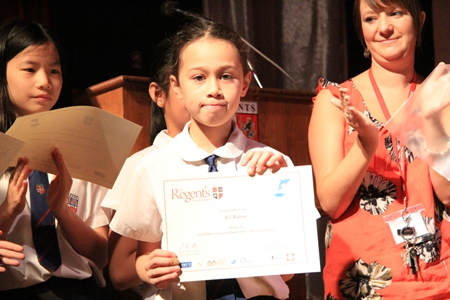How much do you know about dolphins?
The English Department at The Regent’s School organized a ‘Save the Dolphins’ research week for years 7, 8 and 9. Students and staff at The Regent’s School were inspired to help raise awareness of the capture and training of dolphins for captivity after the star of the movie documentary ‘The Cove’, Ric O’Barry, visited the school last term.
Students took part in a range of research activities designed to provide them with accurate, yet sometimes harrowing, information surrounding the capturing and training of dolphins used for entertainment in aquariums around the world. Impassioned and outraged by their discoveries, Regent’s students set to work on writing articles and designing posters with the intention of providing Pattaya’s general public with an informed perspective on the topic.
 Competition winner Bel Walton receiving her certificate.
Competition winner Bel Walton receiving her certificate.
Over 120 students entered a competition to have their article published and contribute to raising awareness of ‘Ric O’Barry’s Dolphin Project’ campaign.
Here is the winning article: “How much do you know about dolphins?” by Bel Walton, Year 7.
People often wonder whether there is life out there in space. Whether there is another race, with the brains of a human. But those people are barking up the wrong tree. What if there was a race down here on Earth? What if there was an animal evolving with brains that could compete with that of a human? What if 1,000,000 years from now the Earth was ruled not by man, but the humble dolphin. The possibility is there.
Dolphins are an incredible species! Their intelligence is amazing. Not only do they have a language of their own, they also have a structure of society. Very much like humans, they must work hard, and find their place in the world. They also have clever hunting strategies, from using tools, to laying bait for traps. Another thing that humans and dolphins have in common, is personal and individual identification. This means that if their calf is being murdered before their very eyes, they know it, they feel it. On many an occasion, they have saved the lives of humans, when there’s been a shark attack, or someone is drowning.
Dolphins today face one major danger. The human. They say that about 20,000 dolphins die every year. A caught dolphin is a dead dolphin, whether they are murdered for meat, or sold to a Dolphinarium for entertainment. During the capture, boats with metal poles sticking out of the bottom, will be banged on the top with hammers to create a wall of sound. Dolphins, being sonar animals are thrown into a state of panic and are easily herded into a bay or cove. Their trainers pick out the ones they want (usually the young females), and have them taken away. The remaining animals are then massacred. One of the most shocking facts about this is that they are not even killed in a quick, systematic fashion. Instead, sharp poles are plunged into the water, piercing the skin of the dolphins, causing them to splash around in agony. By the end of the day, the sea is red with blood. Male, female and young. All dead. How can we call ourselves the upper life-form, yet still murder these innocent animals who have never done anything, but help us? An example of this type of massacre is in Taiji, Japan. There is a documentary on it called ‘The Cove’, starring Ric O’Barry, a dolphin activist.
There are people in the world who eat dolphin meat. Mostly, these people don’t know about the murder. And even those who do, usually don’t know about how dangerous it is. Dolphins contain the same levels of mercury as humans do. Their meat contains 5 times the maximum advised amount of mercury in food. The Mercury eats at your brain cells, and can result in the births of deformed children and worse. “If you’re eating dolphin meat, you’re eating poison, and if you’re eating a lot of dolphin meat, you’re eating a lot of poison,” – Louis Psihoyos (“The Cove” director).
Now that you’ve heard about the dolphin murders, you must think that the dolphins that get sold are lucky. Well you’re wrong. In fact, in some cases, they’re worse off. Being sonar, dolphins are sensitive to sound. When they’re performing, the shouts and chatter of the audience, mixed with the boom of the music inflicts a lot of stress on them. The stress can kill them. Also, the fact that many of them have seen their family killed can add to the stress and depression. Most dolphins in dolphinariums do not die of old age, but of stress or injuries due to capture or cruelty. In some places, the dolphins are not very well treated, and can often be found living in pools of their own urine and waste. “The dolphin smile is nature’s greatest deception.” – Ric O’Barry.
As sad as it is, at least there are people out there trying to make a difference. Ric O’Barry is one of these people. Since having Cathy, the dolphin that he trained, die in his arms, Ric has set out to release all captive dolphins. If you would like to support his campaign, go to www.takepart.com/cove.
Other organizations who support the dolphins are: Animal Welfare Institute, Earth Island, Humane Society of the United States, In Defense of Animals, Ocean Alliance, Oceanic Preservation Society, Off the Mat Into the World, Save Japan Dolphins, and The Whaleman Foundation.
The world is ruled by humans. We can determine which animals live and which die out. At the moment there is a fair chance that dolphins will become extinct. Whether they do or not is up to us. There is a new dolphinarium being built here in Pattaya. Do your part and join the campaign to stop it. Because at this rate, we will never find out what dolphins can really do.




